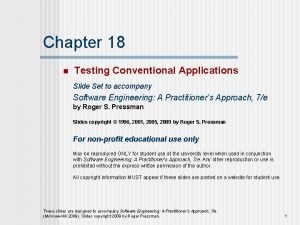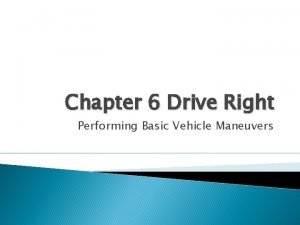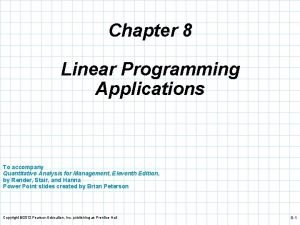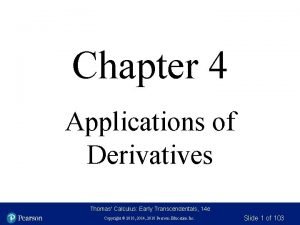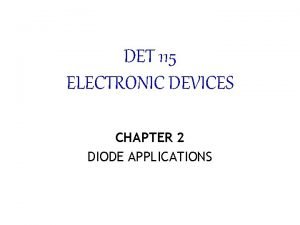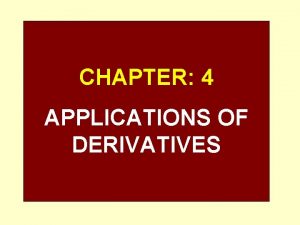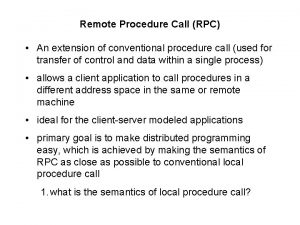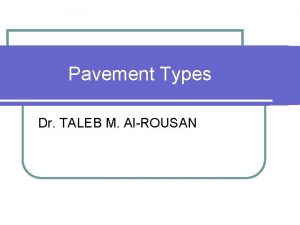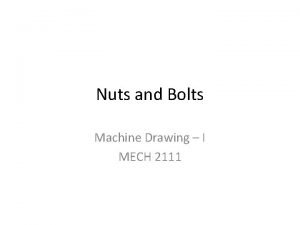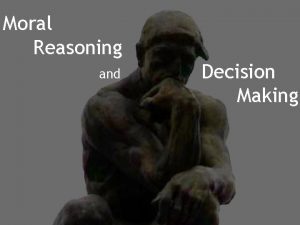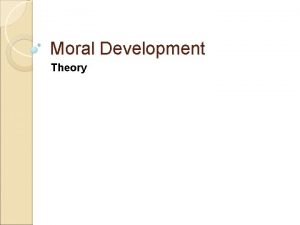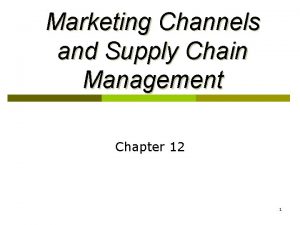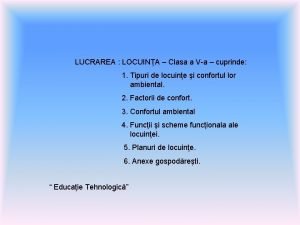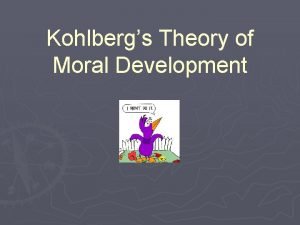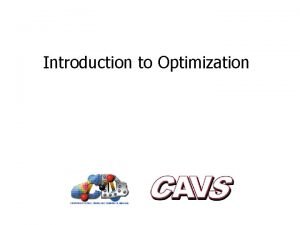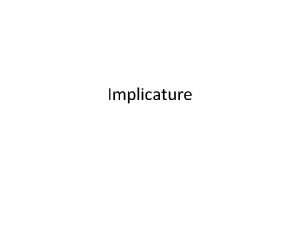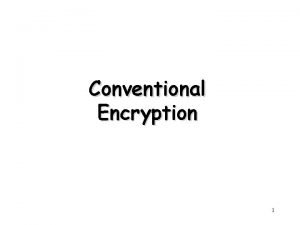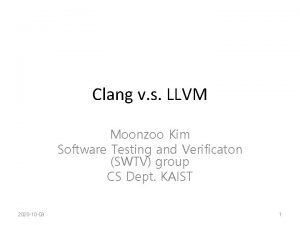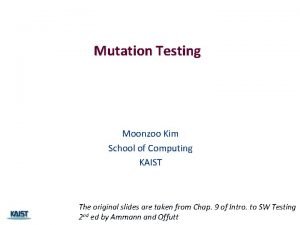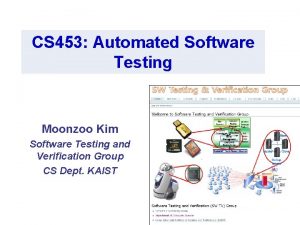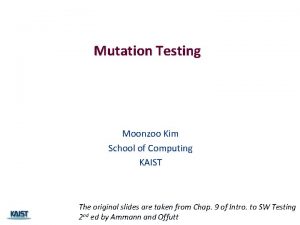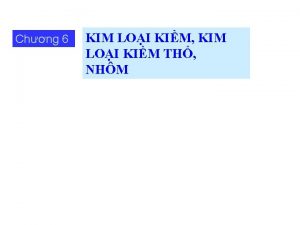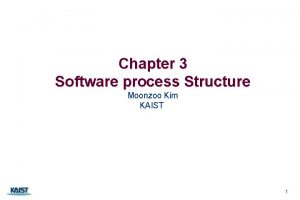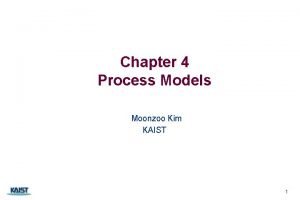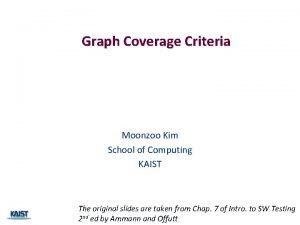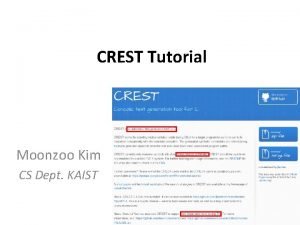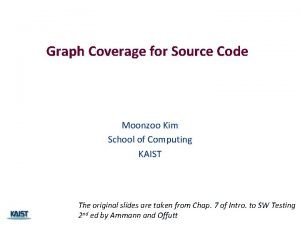Chapter 23 Testing Conventional Applications Moonzoo Kim CS
















































- Slides: 48

Chapter 23 Testing Conventional Applications Moonzoo Kim CS Dept. KAIST CS 350 1

Overview of Ch 23. Testing Conventional Applications n n 23. 1 Software Testing Fundamentals 23. 2 Internal and External Views of Testing 23. 3 White-Box Testing 23. 4 Basis Path Testing n n n Flow Graph Notation Independent Program Paths Deriving Test Cases Graph Matrices 23. 5 Control Structure Testing n n n Condition Testing Data Flow Testing Loop Testing n 23. 6 CS 350 Black-box Testing 2

Testing v. s. Verification Program testing can be used to show the presence of bugs, but never to show their absence! By Edsger W. Dijkstra (1970) n n Testing: to detect bugs Verification: to prove the absence of bugs n n n Verification techniques are much powerful but often not scalable for real-world problems n theorem proving or model checking (CS 408 and CS 453) A good test has a high probability of finding an error A good test is not redundant. CS 350 3

SW Development and Testing Model (a. k. a. V model) Manual Labor Abstraction 4/42 Moonzoo Kim Provable SW Lab


Software Testing Based on SW requirements (high-level testing) white-box methods Based on SW design (model-based testing) grey-box methods Based on SW code structure (low-level testing) black-box methods Methods Strategies CS 350 6

Ex. Testing a Triangle Decision Program SRS should be refined into assert() for testing Input : Read three integer values from the command line. The three values represent the length of the sides of a triangle. Output : Tell whether the triangle is • 부등변삼각형 (Scalene) : no two sides are equal • 이등변삼각형(Isosceles) : exactly two sides are equal • 정삼각형 (Equilateral) : all sides are equal • Black box testing creates test cases to check if the program satisfies SRS : (3, 4, 5), (2, 2, 1), (1, 1, 1), (3, 1, 1) • White box testing creates test cases to check all program branches are covered: 7/21 Moonzoo Kim

(3, 4, 5) “Software (1, 1, 1) Testing a (3, 1, 1) craftsman’s approach” 2 nd ed by P. C. Jorgensen (no check for positive inputs) 8/21 (2, 2, 1) Moonzoo Kim

Designing Unique Tests (pg 499) • Vinod: So let's see. . . you note that the correct password will be 8080, right? • Ed: Uh huh. • Vinod: And you specify passwords 1234 and 6789 to test for errors in recognizing invalid passwords? • Ed: Right, and I also test passwords that are close to the correct password, see. . . 8081 and 8180. • Vinod: Those are okay, but I don't see much point in running both the 1234 and 6789 inputs. They're redundant. . . test the same thing, don't they? • The scene: – Vinod's cubical. • The players: – Vinod, Ed members of the Safe. Home software engineering team. • The conversation: • Vinod: So these are the test cases you intend to run for the password validation operation. • Ed: Yeah, they should cover pretty much all possibilities for the kinds of passwords a user might enter. CS 350 9

• Ed: Well, they're different values. • Vinod: That's true, but if 1234 doesn't uncover an error. . . in other words. . . the password validation operation notes that it's an invalid password, it is not likely that 6789 will show us anything new. • Ed: I see what you mean. • Vinod: I'm not trying to be picky here. . . it's just that we have limited time to do testing, so it's a good idea to run tests that have a high likelihood of finding new errors. CS 350 10 • Ed: Not a problem. . . I'll give this a bit more thought. CS 350 10

White-Box Testing . . . our goal is to ensure that all statements and conditions have been executed at least once. . . (statement coverage, branch coverage, path coverage, MC/DC coverage, etc) CS 350 11

Hierarchy of Structural/graph SW Coverages Complete Value Coverage CVC Complete Path Coverage CPC All-DU-Paths Coverage ADUP All-uses Coverage AUC All-defs Coverage ADC (SW) Model checking Concolic testing Prime Path Coverage PPC Edge-Pair Coverage EPC Edge Coverage EC Node Coverage NC Complete Round Trip Coverage CRTC Simple Round Trip Coverage SRTC 12/60

Exhaustive Path Testing loop < 20 X There are 1014 (= 520) possible paths! If we execute one test per millisecond, it would take 3, 170 years to test this program!! However, advanced automated testing techniques such as symbolic model checking can analyze more than 1014 test scenarios in minutes (see CS 453) CS 350 13

fact=1, i=0 Example no int factorial( unsigned char n) { unsigned char fact=1, i=0; if( n == 0) fact=1; // 0!=1 for(i=1; i <= n; i++) fact = fact * i; return fact; } Statement <= Branch <= Path Coverage coverage CS 350 n==0 yes fact=1 i=1 no i <= n yes fact=fact * i i++; return fact 14

Basis Path Testing: Flow Graph Notation CS 350 15

Basis Path Testing: an Independent Path n n An independent path is any path through the program that introduces at least one new statement or a new condition. Ex. A set of independent paths n n n But the following path is not n n Path 1: 1 -11 Path 2: 1 -(2, 3)-(4, 5)-10 -1 -11 Path 3: 1 -(2, 3)-6 -8 -9 -10 -1 -11 Path 4: 1 -(2, 3)-6 -7 -9 -10 -1 -11 1 -(2, 3)-(4, 5)-10 -1 -(2, 3)-6 -8 -9 -10 -1 -11 Paths 1, 2, 3, and 4 constitute a basis set n If tests can be designed to exercise a basis set, the followings can be guaranteed. n Every statement will be executed at least once n Every condition will be executed on its true and false sides CS 350 16

Basis Path Testing: How Many Paths? • First, we compute the cyclomatic complexity, which is a quantitative measure of the logical complexity • Cyclomatic complexity defines the # of independent paths to test for complete statement/branch coverage - number of simple decisions + 1 - number of edge – number of node +2 - number of enclosed areas + 1 - In this case, V(G) = 4 V(G) is the upper bound for the # of independent paths for complete coverage CS 350 17

Basis Path Testing Next, we derive the independent paths: (paths containing a new edge) 1 2 3 4 5 6 Path 1: Path 2: Path 3: Path 4: 7 8 CS 350 Since V(G) = 4, there are four paths 1, 2, 3, 6, 7, 8 1, 2, 3, 5, 7, 8 1, 2, 4, 7, 8 Finally, we should derive test cases to exercise these paths 18

Cyclomatic Complexity A number of industry studies have indicated that the higher V(G), the higher the probability or errors. modules V(G) modules in this range are more error prone CS 350 19

Using Cyclomatic Complexity (pg 504) n The scene: n n The players: n n n Shakira's cubicle. Vinod, Shakira members of the Safe. Home software engineering team who are working on test planning for the security function. The conversation: Shakira: Look. . . I know that we should unit test all the components for the security function, but there a lot of 'em and if you consider the number of operations that have to be exercised, I don't know. . . CS 350 n n n maybe we should forget white-box testing, integrate everything, and start running black-box tests. Vinod: You figure we don't have enough time to do component tests, exercise the operations, and then integrate? Shakira: The deadline for the first increment is getting closer than I'd like. . . yeah, I'm concerned. Vinod: Why don't you at least run white-box tests on the operations that are likely to be the most error prone? 20

n n n Shakira (exasperated): And exactly how do I know which are likely to be the most error prone? Vinod: V of G. Shakira: Huh? Vinod: Cyclomatic complexity--V of G. Just compute V(G) for each of the operations within each of the components and see which have the highest values for V(G). They're the ones that are most likely to be error prone. Shakira: And how do I compute V of G? CS 350 n n Vinod: It's really easy. Here's a book that describes how to do it. Shakira (leafing through the pages): Okay, it doesn't look hard. I'll give it a try. The ops with the highest V(G) will be the candidates for white-box tests. Vinod: Just remember that there are no guarantees. A component with a low V(G) can still be error prone. Shakira: Alright. But at least this'll help me to narrow down the number of components that have to undergo white-box testing. 21

Basis Path Testing Notes you don't need a flow chart, but the picture will help when you trace program paths count each simple logical test, compound tests count as 2 or more basis path testing should be applied to critical modules CS 350 22

Prime Path Coverage n Def. Prime Path n A path from ni to nj A is a prime path if it is a simple path and it does not appear as a proper subpath of any other simple path n 3 n 1 n 0 n 5 n 4 n 2 n 6 23

Why More than Path Coverage? n A flow graph does not reflect a real imperative program n A state of a real imperative program consists of values of variables while graph theory considers a node as a simple entity // Only one path exists // Suppose we use a test case of x=0, and y=0 int adder(int x, int y) { return 0; } n Most complicated error is caused from loop construct n n Coverage test does not consider loop Therefore, statement/branch/path coverage testing should not be considered as complete analysis Those coverage does not consider value analysis n Dijkstra said that testing cannot show the absence of a bug, but CS 350 a presence of a bug in this sense n 24

Model Checking Basics n Specify requirement properties and build a system model n n Similar to a test oracle and a target software under testing (SUT) in testing Generate all possible states (containing values of variables) from the model and then check whether given requirement properties are satisfied within the state space OK System model Requirement properties 25 Model Checking (state exploration) (F W) or Counter example(s)

An Example of Model Checking ½ 26 (checking every possible values of variables) System Spec. unsigned char x=0; unsigned char y=0; void proc_A() {// Thread 1 while(1) x++; } void proc_B() {Thread 2 while(1) if (x>y) y++; } Req. Spec 26 x: 0, y: 0 x: 1, y: 1 x: 2, y: 0 x: 2, y: 1 x: 2, y: 2 x: 255, y: 255 x: 255, y: 0 x: 0, y: 1 x: 0, y: 255 x: 1, y: 0 x: 1, y: 1 x: 1, y: 255 x: 2, y: 0 x: 2, y: 1 x: 2, y: 255 x: 255, y: 0 x: 255, y: 1 always (x >= y) x: 255, y: 255 Overflow

An Example of Model Checking 2/2 (checking every possible thread scheduling ) char cnt=0, x=0, y=0, z=0; void process() { char me = _pid +1; /* me is 1 or 2*/ again: x = me; Software If (y ==0 || y== me) ; locks else goto again; Process 0 x=1 y==0 || y == 1 z =me; If (x == me) ; else goto again; y=2 (z==2) cnt++ y=me; If(z==me); else goto again; } /* enter critical section */ Critical cnt++; section assert( cnt ==1); cnt --; Mutual goto again; 27 Process 1 x=2 y==0 || y ==2 z=2 x==2 Exclusion Algorithm z=1 x==1 y=1 z == 1 cnt++ Violation detected !!! Counter Example 27

Model Checking Example: Bubble Sort #include <stdio. h> #define N 4 int main(){ int data[N], i, j, tmp; /* It misses the last element, i. e. , data[N-1]*/ 1: for (i=0; i<N-1; i++) { 2: for (j=i+1; j<N-1; j++) { 3: if (data[i] > data[j]) { 4: tmp = data[i]; data[i] = data[j]; data[j] = tmp; } } } 5: /* Check the array is sorted */ } 28 • There exist at most 8 (2 x 2 x 2) simple paths • However, the following test cases fail to detect the bug (0, 1, 2, 3), (0, 2, 1, 3), (1, 0, 2, 3), (1, 2, 0, 3) (2, 0, 1, 3) (2, 1, 0, 3) • A number of possible states is (232)4 = 3. 4 x 1038 • Suppose that 1 test takes 1 microsecond total testing takes 3. 4 x 1032 seconds (= 1025 years) • However, SAT based model checking completes the analysis in 1 second •

Graph Matrices n n n A graph matrix is a square matrix whose size (i. e. , number of rows and columns) is equal to the number of nodes on a flow graph Each row and column corresponds to an identified node, and matrix entries correspond to connections (an edge) between nodes. By adding a link weight to each matrix entry, the graph matrix can become a powerful tool for evaluating program control structure during testing CS 350 29

Control Structure Testing n Condition testing n n a test case design method that exercises the logical conditions contained in a program module Data flow testing n selects test paths of a program according to the locations of definitions and uses of variables in the program CS 350 30

Data Flow Testing n For a statement S n n n A definition-use (DU) chain of variable X is of the form [X, S, S’] where S and S’ are statement, X is in DEF(S) and USE(S’) void f() { n n n DEF(S) = {X| statement S contains a definition of X} USE(S) = {X| statement S contains a use of X} [x, s 1, s 3] is a DU chain [y, s 1, s 3] is NOT a DU chain A branch is not guaranteed to be covered by DU testing s 1: int x = 10, y; s 2: if ( …) { … s 3: y = x + 1; } CS 350 31

Loop Testing Simple loop Nested Loops Concatenated Loops CS 350 Unstructured Loops 32

Loop Testing: Simple Loops Minimum conditions—Simple Loops 1. skip the loop entirely 2. only one pass through the loop 3. two passes through the loop 4. m passes through the loop m < n 5. (n-1), n, and (n+1) passes through the loop where n is the maximum number of allowable passes CS 350 33

Loop Testing: Nested Loops Start at the innermost loop. Set all outer loops to their minimum iteration parameter values. Test the min+1, typical, max-1 and max for the innermost loop, while holding the outer loops at their minimum values. Move out one loop and set it up as in step 2, holding all other loops at typical values. Continue this step until the outermost loop has been tested. Concatenated Loops If the loops are independent of one another then treat each as a simple loop else* treat as nested loops endif* for example, the final loop counter value of loop 1 is used to initialize loop 2. CS 350 34

Black-Box Testing requirements output input CS 350 events 35

Black-Box Testing n n n n How is functional validity tested? How is system behavior and performance tested? What classes of input will make good test cases? Is the system particularly sensitive to certain input values? How are the boundaries of a data class isolated? What data rates and data volume can the system tolerate? What effect will specific combinations of data have on system operation? CS 350 36

Graph-Based Methods To understand the objects that are modeled in software and the relationships that connect these objects In this context, we consider the term “objects” in the broadest possible context. It encompasses data objects, traditional components (modules), and object-oriented elements of computer software. CS 350 37

Equivalence Partitioning user queries CS 350 mouse picks FK input output formats prompts data 38

Sample Equivalence Classes Valid data user supplied commands responses to system prompts file names computational data physical parameters bounding values initiation values output data formatting responses to error messages graphical data (e. g. , mouse picks) Invalid data outside bounds of the program physically impossible data proper value supplied in wrong place CS 350 39

Boundary Value Analysis user queries mouse picks FK input output formats prompts input domain CS 350 data output domain 40

Comparison Testing n Used only in situations in which the reliability of software is absolutely critical (e. g. , human-rated systems) n n n Separate software engineering teams develop independent versions of an application using the same specification Each version can be tested with the same test data to ensure that all provide identical output Then all versions are executed in parallel with real-time comparison of results to ensure consistency CS 350 41

Orthogonal Array Testing n Used when the number of input parameters is small and the values that each of the parameters may take are clearly bounded CS 350 42

Testing Methods n Fault-based testing n n Class Testing and the Class Hierarchy n n The tester looks for plausible faults (i. e. , aspects of the implementation of the system that may result in defects). To determine whether these faults exist, test cases are designed to exercise the design or code. Inheritance does not obviate the need for thorough testing of all derived classes. In fact, it can actually complicate the testing process. Scenario-Based Test Design n Scenario-based testing concentrates on what the user does, not what the product does. This means capturing the tasks (via use-cases) that the user has to perform, then applying them and their variants as tests. CS 350 43

OOT Methods: Random Testing n Random testing n n n identify operations applicable to a class define constraints on their use identify a miminum test sequence n n an operation sequence that defines the minimum life history of the class (object) generate a variety of random (but valid) test sequences n CS 350 exercise other (more complex) class instance life histories 44

OOT Methods: Partition Testing n n reduces the number of test cases required to test a class in much the same way as equivalence partitioning for conventional software state-based partitioning n n attribute-based partitioning n n categorize and test operations based on their ability to change the state of a class categorize and test operations based on the attributes that they use category-based partitioning n categorize and test operations based on the generic function each performs CS 350 45

OOT Methods: Inter-Class Testing n Inter-class testing n n For each client class, use the list of class operators to generate a series of random test sequences. The operators will send messages to other server classes. For each message that is generated, determine the collaborator class and the corresponding operator in the server object. For each operator in the server object (that has been invoked by messages sent from the client object), determine the messages that it transmits. For each of the messages, determine the next level of operators that are invoked and incorporate these into the test sequence CS 350 46

OOT Methods: Behavior Testing The tests to be designed should achieve all state coverage [KIR 94]. That is, the operation sequences should cause the Account class to make transition through allowable states CS 350 47

Testing Patterns Pattern name: pair testing Abstract: A process-oriented pattern, pair testing describes a technique that is analogous to pair programming (Chapter 4) in which two testers work together to design and execute a series of tests that can be applied to unit, integration or validation testing activities. Pattern name: separate test interface Abstract: There is a need to test every class in an object-oriented system, including “internal classes” (i. e. , classes that do not expose any interface outside of the component that used them). The separate test interface pattern describes how to create “a test interface that can be used to describe specific tests on classes that are visible only internally to a component. ” [LAN 01] Pattern name: scenario testing Abstract: Once unit and integration tests have been conducted, there is a need to determine whether the software will perform in a manner that satisfies users. The scenario testing pattern describes a technique for exercising the software from the user’s point of view. A failure at this level indicates that the software has failed to meet a user visible requirement. [KAN 01] CS 350 48
 Testing conventional applications in software engineering
Testing conventional applications in software engineering Testing conventional applications in software engineering
Testing conventional applications in software engineering Ultrasonic inspection machine
Ultrasonic inspection machine Hp loadrunner for mobile performance testing
Hp loadrunner for mobile performance testing Acoustic emission testing applications
Acoustic emission testing applications Testing soa applications
Testing soa applications Domain closure in software testing
Domain closure in software testing Logic based testing in software testing
Logic based testing in software testing Du path testing
Du path testing Positive testing vs negative testing
Positive testing vs negative testing Static testing and dynamic testing
Static testing and dynamic testing Globalization testing example
Globalization testing example Functional testing vs unit testing
Functional testing vs unit testing Cause effect graphing technique
Cause effect graphing technique Control structure testing in software testing
Control structure testing in software testing Decision table testing in software testing
Decision table testing in software testing Decision table testing example
Decision table testing example Apa itu black box testing
Apa itu black box testing Behavior testing adalah
Behavior testing adalah Decision table based testing in software testing
Decision table based testing in software testing Rigorous testing in software testing
Rigorous testing in software testing Testing blindness in software testing
Testing blindness in software testing Component testing is a black box testing
Component testing is a black box testing Software testing domains
Software testing domains Kim wilde persepolis
Kim wilde persepolis Chapter 3 skills and applications
Chapter 3 skills and applications Types of turnabouts
Types of turnabouts Principles of economics chapter 28 answers
Principles of economics chapter 28 answers Chapter 23:3 administering heat/cold applications
Chapter 23:3 administering heat/cold applications Chapter 8 linear programming applications solutions
Chapter 8 linear programming applications solutions Chapter 4 applications of derivatives
Chapter 4 applications of derivatives The life skill using community resources means
The life skill using community resources means Line regulation
Line regulation Chapter 4 applications of derivatives
Chapter 4 applications of derivatives Decorative design pattern
Decorative design pattern List some remote procedure call (rpc) issues.
List some remote procedure call (rpc) issues. Flexible pavement cross section
Flexible pavement cross section Conventional representation of external thread
Conventional representation of external thread Social conventional reasoning
Social conventional reasoning Post conventional reasoning
Post conventional reasoning Social contract
Social contract Marketing channels and supply chain management
Marketing channels and supply chain management Schema functionala a locuintei
Schema functionala a locuintei Runaway trolley
Runaway trolley Kohlberg's stages of moral development
Kohlberg's stages of moral development Good boy, nice girl orientation
Good boy, nice girl orientation Conventional design approach
Conventional design approach Ready prepared foodservice system
Ready prepared foodservice system What is conversational implicature
What is conversational implicature

